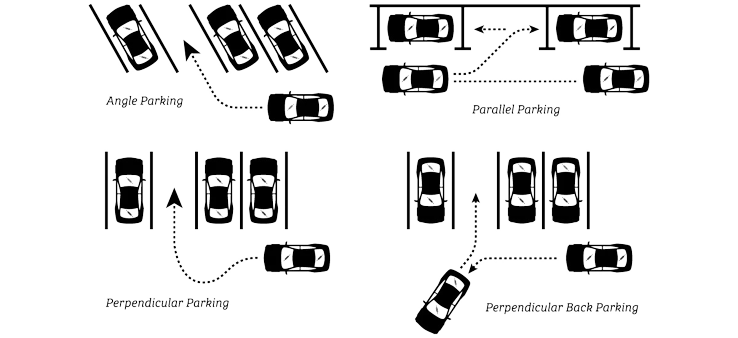Parking and Road Safety
Traffic and Parking Problem
With the increase in population of motor vehicles, the problem of parking is also getting worse. It is roughly estimated that out of 8,760 hours in a year, the car runs on an average for only 400 hours which is around 4.5% of the total time. Problem is also arising due to the fact that people that do not have parking space are also buying car. Not only do vehicles require street space to move about, but they also require space to park. This results in a great demand for parking space and other areas where the activities are concentrated. Every car owner would wish to park the car as closely as possible to his destination so as to minimise his walking.
Common Methods of Parking
There are different forms of on street parking which are as follows:
-
Parallel Parking
-
Angular Parking
-
Perpendicular Parking

Parallel parking consumes the maximum kerb length which decreases as the angle of parking increases. The minimum kerb length is consumed by right angle parking, which accommodates nearly 2 times the number of vehicles as parallel parking. On the other hand, parallel parking makes the least use of the width of the street, and this is an important consideration in narrow streets. As the parking angle increases the width of street decreases. Based on the angle of parking there are different types of parking such as 30° angle parking, 45° angle parking, 60° angle parking and or Perpendicular Parking. In terms of safety angular parking is hazardous as compared to parallel parking. Considering the above, it is recommended that in general Parallel Parking should be favoured on streets. On exceptionally wide streets and having considerable traffic volume consideration should be given for Angular Parking.
Though on-street parking is an extravagant use of the precious street space, it cannot entirely be prohibited. A judicious application of appropriate traffic management measures shall help mitigate some of the ill effects of on-street parking. These measures should be a part of the comprehensive parking policy for the town formulated from a careful survey of a street. The regulatory authority shall decide that where vehicles should be parked, what should be the waiting time and what charges should be levied for parking.
Prohibited Parking
It is desirable to prohibit parking at certain locations for a period to ensure safety and convenience. Such locations are :
Near Intersection
The capacity of an intersection is greatly reduced if vehicles are allowed to park on the approaches. Visibility is also adversely affected and safety is reduced. It is the general practice to prohibit parking for a distance of about 50 m on the approaches to a major intersection.
Narrow Streets
Narrow streets with heavy traffic require that all possible measures should be taken to remove obstacles to traffic flow. Prohibition of parking can have prominent effect on traffic flow and congestion. In busy streets of the central area, it is generally desirable to prohibit parking on two-way streets less than 5.75 m wide and one-way streets less than 4.0 m wide.
Pedestrian Crossings
As already mentioned, parking manoeuvres cause accidents and pedestrians are the worst sufferers. Parked cars obstruct the visibility at pedestrian crossings. For these reasons, it is desirable to prohibit parking within about 8 meters from the pedestrian crossing.
Structures
Structures such as bridges, tunnels and underpasses generally have a roadways width less than the highway and for this reason it is desirable to prohibit parking on them.
Entrance Driveways
Vehicles should be prohibited from parking in front of entrance driveways leading to houses and buildings.
Effects of Parking
Traffic Congestion
As a result of on street parking the street space is reduced which caused traffic congestion. This drops the journey speed and enhances the journey time. As a result, in increases the operational cost of the vehicle and poses huge loss.
Road Crashes
The manoeuvres associated with parking also cause severe road accidents. Especially heavy vehicles parked on the highway results in severe or fatal accidents. Careless opening of the doors of parked vehicles at times also become cause of crash. Hence, parking should be done safely to ensure prevention of road crashes.
Obstruction to Emergency Response Vehicles
Parked cars obstruct the movement of Emergency Response Vehicles and greatly Impede their operations. They block access to hydrants and access to buildings.
Environment
Parked vehicles degrade the environment of the town and cities. Stopping and starting of vehicles result in noise and pollution. Noise and vehicle pollution are the two important environment threats.


